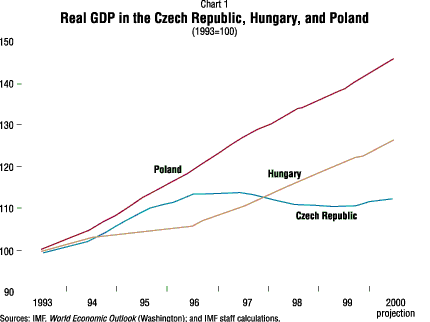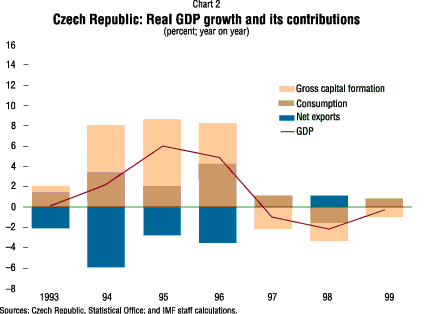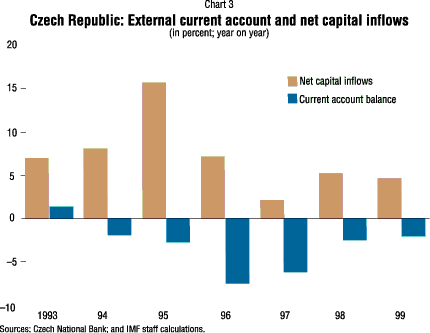 About F&D Subscribe Back Issues Write Us Copyright Information Use the free Adobe Acrobat Reader to view a pdf file of this article
|
Supplement Prague, the capital of the Czech Republic, is the setting for this year's Annual Meetings of the International Monetary Fund and the World Bank Group. This is the first year in which the meetings are being held in one of the economies in transition. This special supplement to Finance & Development opens with an article describing the striking progress that the Czech Republic has made in transforming itself into a market economy and outlining some of the remaining challenges it faces as it prepares for membership in the European Union. The IMF staff's latest World Economic Outlook and International Capital Markets reports, whose main features are described below, will also be released at the meetings. Finally, we provide a preview of the agenda for the Annual Meetings. Czech Republic: Recent Developments and Current Outlook The Czech Republic has made enormous strides in establishing a market economy and, despite having one of the largest state sectors at the beginning of its transformation, is now among the most advanced transition countries. The private sector's share of GDP rose from less than 5 percent in 1990 to nearly 80 percent in 1999. Significant progress has been made in nominal convergence, with inflation declining to the low single digits in 1999 from 10-15 percent during the mid-1990s (see table). The Czech Republic's per capita GDP, which was $5,230 in 1999, remains above those of Hungary and Poland, but the differential has eroded, especially during recent years, owing to a protracted recession (Chart 1). At the same time, its per capita GDP is just one-quarter of the European Union (EU) average, so the Czech Republic has a long way to go to catch up with its western neighbors.

|
The Czech Republic's transition has not always been smooth, however. Despite several years of enviable economic performance, with annual growth rates averaging 4 1/4 percent during 1994-96 (Chart 2), difficulties began to emerge in 1996, when the country's current account deficit widened to 7.4 percent of GDP (Chart 3), culminating in a currency crisis and a protracted recession. An unreformed enterprise sector—resulting from the diffuse structure of ownership that emerged from the voucher privatization program—and imprudent lending by largely state-owned banks permitted excessive wage increases and labor hoarding (that is, firms being reluctant to lay off excess workers). Consequently, the external competitiveness of Czech firms declined, which increased the country's current account deficit and undermined confidence in its currency, the koruna. Contractionary monetary and fiscal policies that were implemented in response to the currency crisis brought down inflation and reduced the current account deficit but contributed to a sharp economic downturn. GDP contracted by an average of more than 1 percent a year during 1997-99, and the unemployment rate rose sharply to more than 9 percent at the end of 1999 from 3 percent in 1996.

 A modest recovery, which began in the second quarter of 1999, has now firmly taken hold, underpinned by strong growth in the European Union (the Czech Republic's largest trading partner), a loosening of macroeconomic policies, and a surge in foreign direct investment. In the near term, however, economic growth will be restrained by ongoing banking and corporate sector restructuring, which will dampen domestic investment and consumption. In the longer term, the pace of expansion will be weaker than in other advanced transition economies unless progress in reducing the backlog of structural reforms is stepped up. The challenge for the Czech Republic is to increase real per capita incomes to EU levels. In order to facilitate export-led growth, structural reforms should be accelerated. Large loss-making enterprises should be weaned off government support and unviable firms closed. To reduce the duration of unemployment for those laid off through this process, employment creation and job searching should be encouraged, including by cutting back on generous social assistance and promoting labor mobility by, for example, eliminating rent controls. Bank privatization should be completed and banks' internal controls strengthened to improve the efficiency of credit allocation. Legal reforms are also needed to enhance creditor rights and develop a speedy and predictable judicial process. Fiscal consolidation is needed to ensure the medium-term sustainability of the government's finances. This is all the more urgent because pressures on the budget are expected to rise in the coming years, owing to costs of qualifying for EU membership, cleaning up the banking and enterprise sectors, and providing pensions and social services to an aging population, as well as a drying up of privatization receipts. Given the large share of nondiscretionary spending in the Czech Republic's budget, there is a clear need to reevaluate the scope of mandatory expenditures, particularly pensions and other social benefits.
Fall 2000 World Economic Outlook The fall 2000 World Economic Outlook contains a buoyant forecast for the global economy, with world GDP growth projected to increase in all of the major regions of the world. This growth is led by the continued strength of the U.S. economy, an accelerating expansion in Europe, and a nascent—though still fragile—recovery in Japan. In emerging markets, economic fundamentals in most countries have strengthened, aided by the consolidation of the recovery in Asia and the rebounds from last year's slowdowns in Latin America and the Middle East. Nevertheless, economic and financial imbalances in the three main currency areas remain large, posing a continued risk to the global expansion. In particular, there is a need to maintain policies designed to achieve an orderly rebalancing of growth and demand across the major currency areas. As the recent unsustainable rate of expansion in the United States gradually slows, these policies will help to ensure that the impact on global growth is offset by an acceleration of activity in the euro area and Japan. The World Economic Outlook also focuses on the experiences of the transition economies that have moved from central planning to market economies—including those of China and other East Asian transition economies. It has been more than twenty years since China began the process of reforming its economy and "opening up" to the outside world, and more than ten years since the Berlin wall came down and economies from Prague to Vladivostok started their transition to market-oriented systems. The text discusses the progress that has been made in developing market-oriented economies and the necessary supporting institutional structures. It also discusses the reform agenda for the future, including the role that a more integrated global economy—for instance, through the expected accession of a number of transition economies to the European Union (EU)—can play in supporting the reform effort. Finally, there is a separate analysis of the issues and challenges posed by the process of accession to the European Union and, eventually, the European single currency, both for the transition countries that are currently accession candidates and for existing EU members. The full text of the World Economic Outlook will be available on the IMF's website, at www.imf.org, from September 19, 2000, and the printed version will be available in October, priced at $42.00 ($35.00 academic rate) a copy.
International Capital Markets Report This year's International Capital Markets report assesses recent developments in mature and emerging financial markets and analyzes key systemic issues affecting global financial markets. Following the most severe market turbulence in the postwar period—characterized by a succession of regional crises that enveloped the major financial markets—credit concerns eased during 1999 and the first half of 2000, and global investors displayed more willingness to take risks. The report discusses the main risks in the period ahead. The report also examines three systemic issues. First, the rapid growth and widespread use of over-the-counter (OTC) derivatives markets has accompanied and driven the globalization of finance. While OTC derivatives instruments and markets have bestowed tremendous benefits, they have also posed risks to global financial stability. The report identifies sources of instability and points to areas where further efforts are required if risks are to be avoided in the future. Second, the report reviews the experience with initiatives to involve the private sector in preventing and resolving crises, along with market assessments of two key instruments used to help resolve recent international payments crises—rollover of interbank lines of credit and restructuring of sovereign foreign-currency bonds. Third, during the past decade, foreign-owned banks have played an increasingly important role in emerging markets, especially in Central Europe and Latin America. The report discusses this role, analyzing the conditions that have stimulated the rise in foreign participation (including the removal of barriers to entry by authorities), the arguments for and against such participation, and the main policy issues. The 2000 report on International Capital Markets Developments, Prospects, and Key Policy Issues will be published by the IMF in September. It will be priced at $42.00 ($35.00 academic rate) a copy. The text will also be made available on the IMF's website, at www.imf.org.
Prague to Be Venue for 2000 IMF/World Bank Annual Meetings The fifty-fifth Annual Meetings of the IMF and the World Bank Group are to convene at the Prague Congress Center on Tuesday, September 26 amid continuing signs of global recovery from the economic crises of the late 1990s. The meetings, which are to continue until Thursday, September 28, offer a unique opportunity for the governors of the IMF and the World Bank to address the major issues facing the global economy and to engage in a dialogue on the policies and operations of the IMF and the World Bank. They will be preceded by meetings of the International Monetary and Financial Committee, the IMF's principal advisory body, on September 24, and of the IMF/World Bank Development Committee, on September 25, as well as other ministerial-level meetings. In addition, a program of IMF/World Bank seminars is being held during the period September 22-25 under the general topic of "Making the Global Economy Work for Everyone." These seminars are to focus on issues of global finance, trade and investment, information and technology, and human development. They are designed to serve as a catalyst to action on the main topics affecting international economic and financial stability and sustainable development. |
|||||||||||||||||||||||||||||||||||||||||||||||||||||||||||||||||||||||||||||||||||||||||||||||||||||||||||||||||||||||||||||||||||||||||||||||||||||||||||||||||||||||||||||||||||||||||||||||||||||